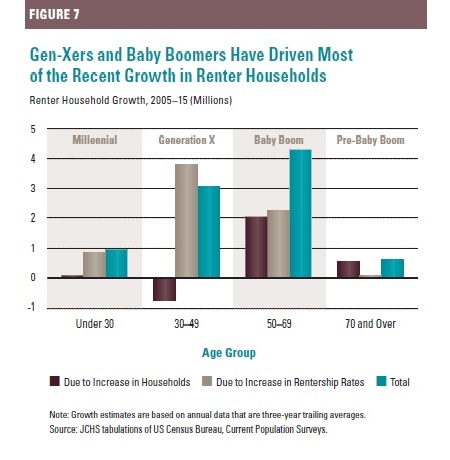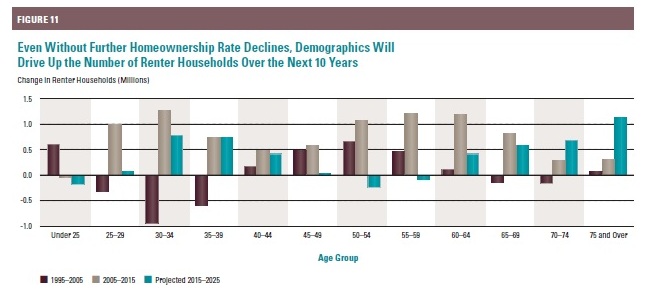There is a new trend in the housing market within the 50-and-over age demographic: Rentals.
Per a new study, conducted by the Joint Center for Housing Studies of Harvard University, there is a rising number of middle-aged home renters.
According to the report, America’s Rental Housing, “recent declines in homeownership rates have lifted the number of middle-aged renters.” In fact, over the last decade, the number households occupied by middle-aged renters increased from 10 million to 15 million. As a result, the 50-and-over demographic accounted for over half of renter growth from 2005 through the third quarter of 2015.
This trend is illustrated in this graph:
 Or, as the authors of the study wrote
Or, as the authors of the study wrote
“Several of the trends behind the recent growth in renters are playing out differently along generational lines. Millennials (born 1985–2004) are coming of age in record numbers, boosting the ranks of adults in their 20s—the prime ages for renting. Meanwhile, members of generation X are remaining renters longer, pushing up the rates for 30–49 year olds. And finally, the baby boomers are driving up the population aged 50 and over, while also renting at higher rates than the previous generation.”
Three Key Demographic Trends Shaping Rental Housing Demand
Because Creating Results’ focus is on marketing to people over 50, we made special note of demographic trends expected to shape rental housing demand over the next decade.
The first expected trend is the aging of my generation, Millennials. As Millennials (currently ages 14 to 33) get older we are expected to double the number of renters. As long as homeownership rates remain static, the number of Millennial renters is expected to increase from 11.3 million to 22.6 million by 2025.
The next trend is an increase in the minority share of households. The demand for rental housing amongst minorities is expected to increase as well, with factors such as strong immigration patterns and the ongoing disparity between white and minority homeownership rates taken into consideration.
The final expected trend is the increase of senior renters.
Boomers account for about 25% of the population. As members of this generation continue to age into the 70-and-over age group, the number of senior renters in America is expected to increase significantly, as illustrated in the graph below.
Most of these renters will have aged in place. However, others are expected to transition into rental housing in order to accommodate their changing accessibility needs.
What the Trends Mean for Marketing Housing to Older Adults
So what do all these trends and numbers actually mean?
Well, for mature marketers, this housing study provides plenty of insight in regards to how to market to your (older adult) target audience now and in the future.
1. Keep in mind that motivation for purchase decisions varies by age.
Marketing messages that resonate with a 55-year-old consumer may not do the same for a 70-year-old consumer due to differences in their life stages. As such, the focus of messages and storytelling should be on those benefits valued by your specific market segment.
2. Before those age/stage messages can be developed, marketers have to know what consumers in their targeted segment value.
For example, one of the key factors that renters ages 50-and-over take into consideration — more so than other generations — is accessibility. Does the house have no-step entry and single floor living? Are there level-style door handles and accessible electric controls? What about extra-wide doors and hallways?
Very few houses in the existing rental stock have the five universal accessibility features needed to adequately accommodate middle-aged and senior renters. If the home you’re offering for rent is one of the few that does, invest in professional photography to accentuate these assets.
3. Don’t dwell on the negatives of physical aging (disability, safety risks). Pump up the positive –ease of bringing groceries in by elevator and/or “visitability.”
4. For marketing to Baby Boomers, remember that they want ALL parts of their new home to be more appealing than their current home.
Shared amenities such as clubrooms, fitness areas and outdoor spaces also need to be accessible and attractive. These are features that prospects don’t have access to in their current homes, so make sure those aspects are emphasized throughout your marketing program.
When you really zero in on the goods and services that address a Boomer or senior need, and you create added value, your consumers will be eager to live the (rental) life that they envision for themselves.
Read the full study: http://www.jchs.harvard.edu/americas-rental-housing



